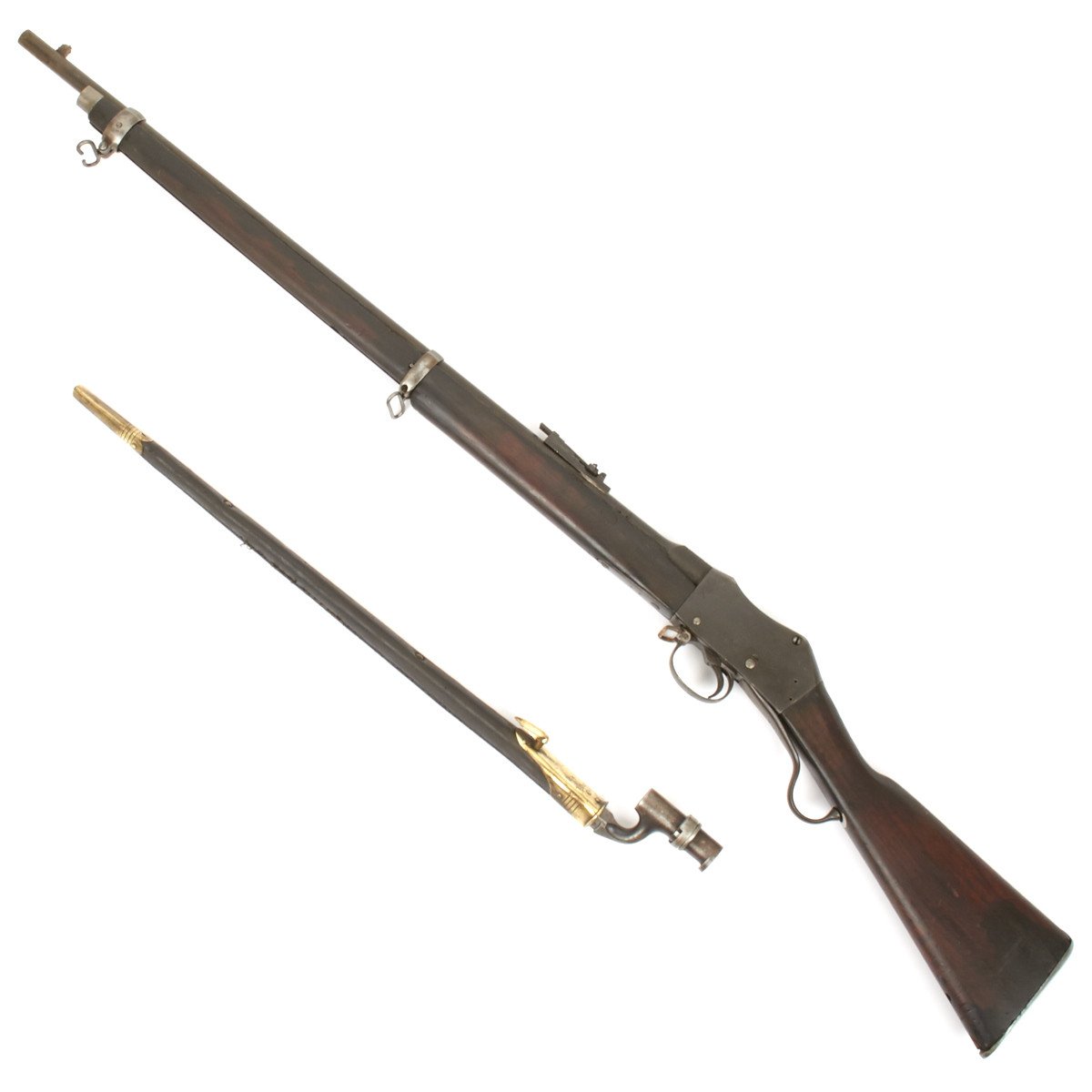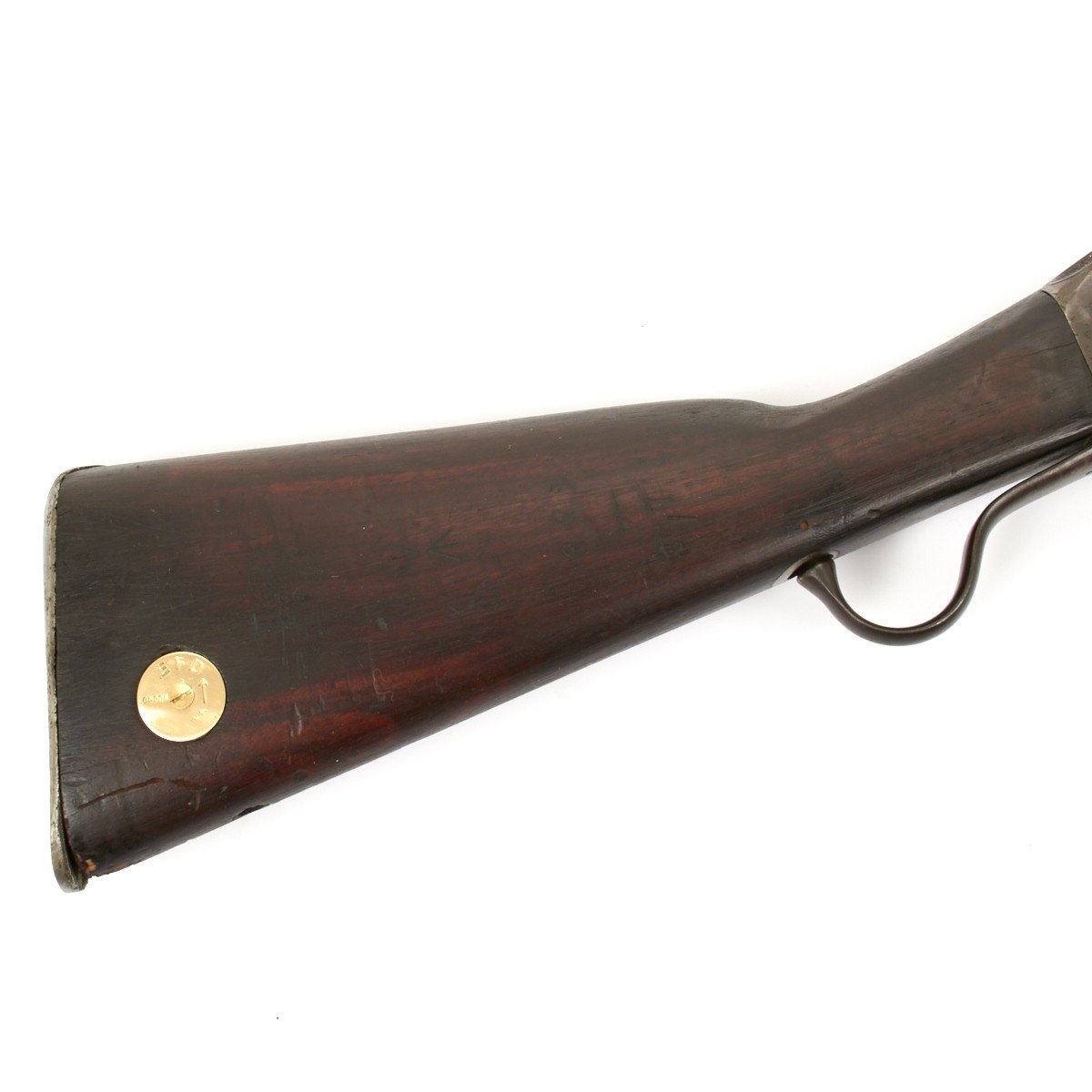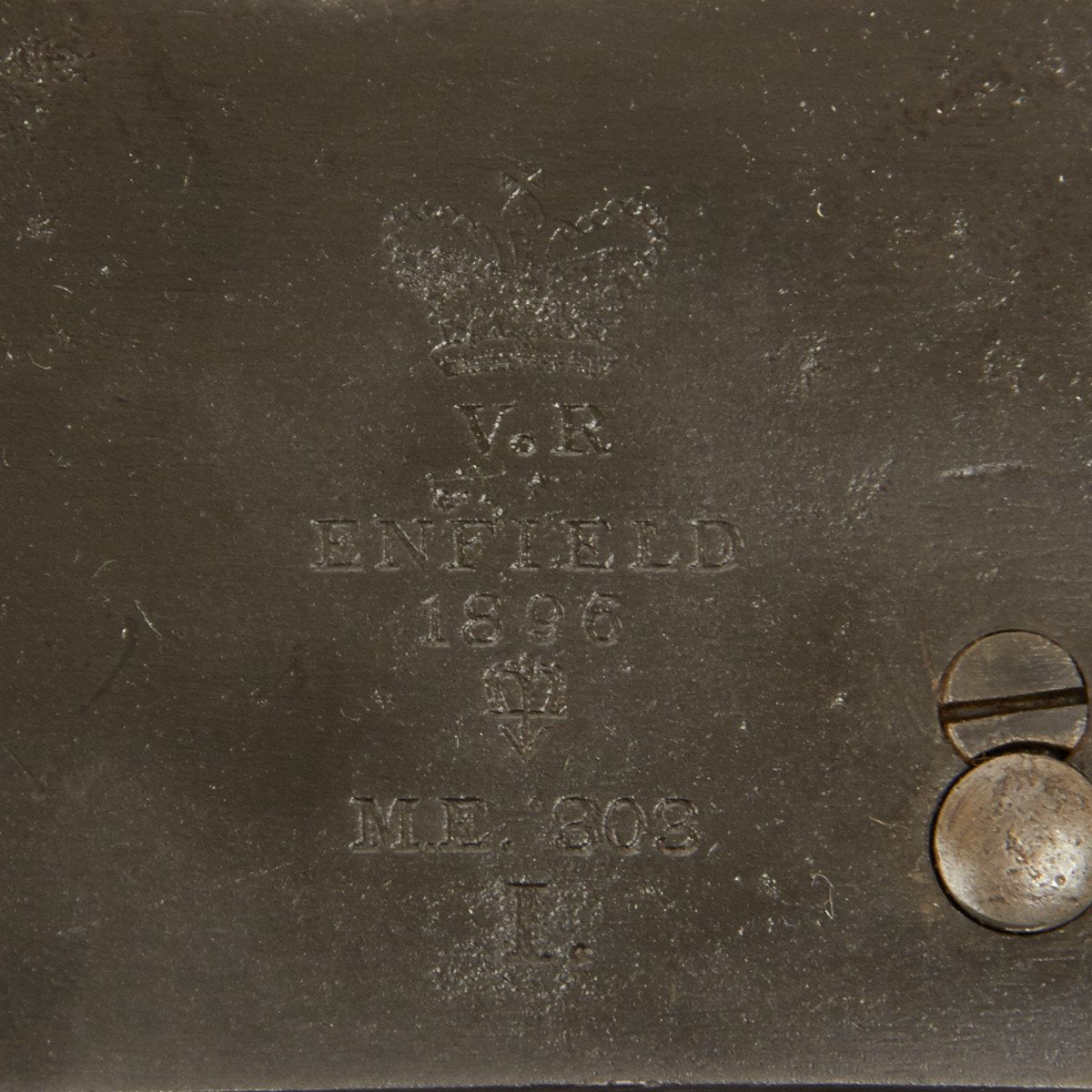Original British Enfield Martini-Henry 1881 MkIII Rifle .303 Conversion with Socket Bayonet Original Items
$ 1.495,00 $ 373,75
Original Item: Only One Available. These are really unusual and have become very hard to find on todays collector market. This is an original Martini Henry Mk III Rifle dating from the 1881 made by Enfield in .45/577 caliber. It was later converted (again by ENFIELD) to .303 caliber in 1896, making it a Martini-Enfield Mk I.
This rifle was re-barreled in 1896 with the new .303 caliber which meant a fresh slimmer fore end had to be fitted. The barrel is covered in British proof and acceptance markings. The breech block was removed and converted to .303 by machining a dovetail into the face, which was then fitted with a new breech block face for the .303 striker that was installed. Also the extractors were replaced, as the originals were far to large to work with .303 British.
The bayonet is a standard P-1876 (450/577 caliber) that was modified and sleeved to fit a .303 barrel. The bayonet, in original full length comes with the original brass mounted leather scabbard. The original British bayonet also bears some Nepalese numeral markings.
History of the Martini Henry MkIII (courtesy of martinihenry)
During the development of the Martini Henry IC1 carbine, the RSAF decided to utilize the same component parts to produce a new mark of rifle, the intention to make the parts interchangeable. On 22nd August 1879, the MkIII rifle was accepted into service LOC 3998 Rifle Breech loading, with Cleaning rod Martini Henry Interchangeable MKIII, it took the same basic form of the MkII rifle, with some re-designed features. The first orders for 30,000 MkIII were placed on the RSAF in 1879, at a cost per rifle of £2.13s.10d, with combined orders for the trade BSA, LSA & NAA fo9r 10,000 arms at a cost of £2.18S.9d. The MkIII. Rifle was designed primarily as an arm for Volunteer, Militia and Dominion governments.
The MkIII was an exercise in durability, the barrel had a new double hump knocks form,primarily to give an enhanced grip when the barrel was held in the breeching vice. Because of this re-design, the lug hole brazed on the underside of the barrel to hold the fore-end and cross pin common to MkI & II rifles were discontinued, as a result The MkIII had the Fore-end Hook method of fixing, a screw fixed metal plate was let into the underside of the forestock, this hooked into a keeper slot grooved into the front of the action, a feature copied from the carbine development. As the walnut fore stock blank no longer needed to be located into the receiver mortice slot, it extends .312 longer along the barrel than the MkII rifle.
During sighting tests, it was found that the Henry rifled barrel affected a natural deflection at ranges beyond 600 yards, as a result the MkIII. sight bed was soldered onto the barrel with a 1 degree 6 minutes left hand of centre bias, resulting that when the back sight ladder was lifted this adjustment corrected the deflection. The MkIII. back sight bed was lengthened by 1/8 (3mm), to give the lowered sight leaf more support
A new pattern Breech block had been approved under order No68 22nd March 1878, and designated pattern III. This new block was made wider to eliminate play in the action when opened and closed, it also utilized a new design of firing pin, .002 narrower at the point to increase clearance. The most obvious change was the firing pin itself, the MkIII design was now fully cylindrical with a diameter of .056 purpose made to be a sliding fit into the spring chamber of the block. The breech block was purposely designed to interchange with all previous marks of rifles and carbines, to make it readily identified, The block was marked with the Roman numeral III, under the WD mark and the Maltese Cross on the opposite side, the stop nut and the rear of the firing pin to be marked similarly.
On 5th March 1883, Viscount Lewisham asked parliamentary question directed to the Secretary of State when he could inform the House how soon the Martini Henry will be served out to the Volunteers?, SoS reported It is not desirable to increase production although we are very anxious to issue the superior arm to the Volunteers as soon as possible, I am afraid I cannot promise them this year
During this time production of MKIII rifles had exceeded 95,000, with orders for the New South Wales Government alone of 6,500 pieces and Canada 5000
The MkIII rifle was made in large quantities, and at the end of production in 1889.
Manufacturers:
RSAF Enfield 1879-1888
Birmingham Small Arms and Metals Co
London Small Arms Co
National Arms and Ammunition Co
Fast Shipping with Professional Packaging
Thanks to our longstanding association with UPS FedEx DHL, and other major international carriers, we are able to provide a range of shipping options. Our warehouse staff is expertly trained and will wrap your products according to our exact and precise specifications. Prior to shipping, your goods will be thoroughly examined and securely secured. We ship to thousands clients each day across multiple countries. This shows how we're dedicated to be the largest retailer on the internet. Warehouses and distribution centres can be located throughout Europe as well as the USA.
Note: Orders with more than one item will be assigned a processing date depending on the item.
Before shipping before shipping, we'll conduct a thorough inspection of the items you have ordered. Today, the majority of orders will be delivered within 48 hours. The delivery time will be between 3-7 days.
Returns
The stock is dynamic and we cannot completely manage it because multiple stakeholders are involved, including our factory and warehouse. So the actual stock may alter at any time. It's possible that you may not receive your order once the order has been made.
Our policy is valid for a period of 30 days. If you don't receive the product within 30 days, we are not able to issue a refund or an exchange.
You can only return an item if it is unused and in the same state as the day you received it. You must have the item in its original packaging.
Related products
Uncategorized
Uncategorized
Uncategorized
Band of Brothers ORIGINAL GERMAN WWII Le. F.H. 18 10.5cm ARTILLERY PIECE Original Items
Uncategorized
Uncategorized
Uncategorized
Uncategorized
Uncategorized
Uncategorized
Uncategorized
Uncategorized
Uncategorized
Uncategorized
Armored Burgonet Helmet & Polearm from Scottish Castle Leith Hall Circa 1700 Original Items
Uncategorized
Uncategorized













































































